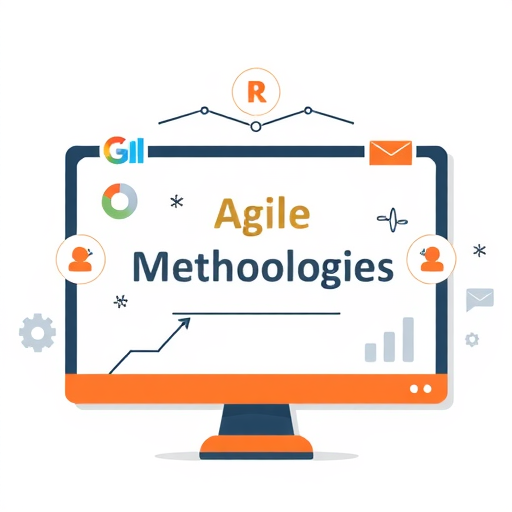In this article, we’ll discuss the 6 best agile methodologies. As project managers, you must eliminate waste, maximize efficiency, ensure smooth delivery, and eliminate roadblocks. To ensure consistency, business adaptability, and alignment, the agile mindset brings techniques to life.

Agile Mindset – the Foundation of Agile Methodologies
Agile is a set of principles and methodologies. The agile manifesto was developed as a response to methods that permeated the world of software development despite being counterproductive and ineffective. Agile methods and techniques are focused on the below-mentioned principles:
- Customer satisfaction is the importance
- Project development with contributors
- In-person interactions are best
- Working software is the best measure of progress
- Adapt and reflect on a continuous basis
The most popular Agile Methodologies
Below are some of the most popular Agile methodologies:
Kanban Method
The Kanban was developed by an engineer at Toyota named Taiichi Ohno for Lean production. Kanban was initially designed for scheduling and facilitates inventory control and production. Known for its capability to yield large quantities of product, Kanban is a method to achieve just-in-time production.
Kanban was first adopted back in the 1940s when Toyota was finding new ways of shelf-stocking methods. When a consumer visits a store, that consumer will get the needed item.
Today, organizations have adopted Knaban as a method to enable visualization of work, be agile, and maximize efficiency.
Kanban ensures stable flow instead of initiating new work. The method is decomposed into six practices and principles. Setting WIP, visualizing workflow, managing workflow, collaborative improvement, and explicit policies will take the process beyond your imagination. Organize feedback loops to lead to powerful outcomes of Kanban.
Scrum
The Scrum framework is a set of development principles. They focus on the managing aspect of projects. The product owner collaborates with the businesses and the team to harness and isolate the system functions in what is termed a product backlog. Team members then distribute the software into increments, called sprints.
Extreme Programming (XP)
Extreme programming involve high participation of parties involved in software exchange i.e. the developers and the customers. The customers inspire the development by identifying the most important features of software through testimonials.
Feature-Driven Development (FDD)
The FDD centers around the developer and involves developing models into builds. In contrast to scrum and XP, feature-driven development centers around strict operations and involves domain walkthroughs including code and inspection. The model includes features for which a design and development plan is deployed. Following a number of inspections, a unit test is conducted to see if it’s ready for the build stage.
Crystal Methodology
The crystal method is a family of agile methods that includes crystal clear, crystal red, crystal yellow, etc. The three main factors that determine the project team are the system criticality, the team size, and project priorities. Project categorization is done based on criticality and has four levels. Huge projects will have many roles and vice versa. Crystal recommends early delivery, less frequency, and higher user involvement. Projects are unique and require applying different practices, processes, and policies. It is therefore perceived as a lightweight approach to agile.
Lean
Lean encourages slowing down progress and instead strengthening the strategies. To eliminate waste, an organization cuts documentation, lengthy meetings, and unproductive tasks. Similarly, lean focuses on aspects that discourages preoccupation with things that might become useful in the future.
What Is the Best Agile Approach
The selection of the agile methodology depends on the processes and demands that factor into the culture of your business. While a specific method might work, it’s difficult to fathom changes that might occur in the information technology world. However, adopting one of the agile approaches can generate new levels of productivity and flexibility among teams.
Conclusion
Despite their specifics and differences, all agile approaches are built on the agile philosophy. Choosing the right approach requires a consideration of all the advantages and disadvantages of the method before you decide which method suits your environment. Regardless of the final choice you make, what matters the most is to keep your team collaborated and ensure smooth processes while adopting to business changes and customer demands.
6 Best Agile Methodologies- FAQs
Which Agile methodology is best suited for frequent changes in requirements?
Kanban is best suited for frequent changes in requirements. It allows for tracking progress and upcoming tasks. It manages and organizes tasks using a board that has three columns including the to-do, doing, and done.
What do all Agile methodologies have in common?
All agile methodologies have a defined, specified iteration duration that allows teams to adapt to business needs and they all use incremental and iterative development.
Which methodology is best for agile?
Scrum is the most popular framework used by project teams.
How should user stories be prioritized in Agile?
To set priorities, team members gather and vote on which stories they want to take first. It is critical to remember that prioritization is done based on features that will lead to a faster product rollout in delivering to the customer.
Do follow our Methodologies Section for more relevant articles
Do watch the Article Video Here
Do subscribe Our YouTube Channel for more relevant videos


